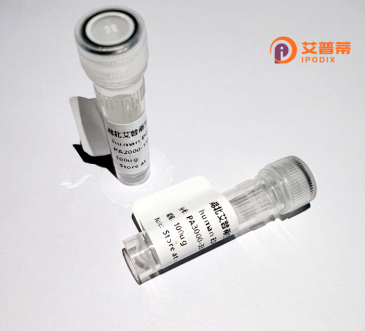
| 纯度 | >90%SDS-PAGE. |
| 种属 | Human |
| 靶点 | GALNT6 |
| Uniprot No | Q8NCL4 |
| 内毒素 | < 0.01EU/μg |
| 表达宿主 | E.coli |
| 表达区间 | 1-622aa |
| 氨基酸序列 | MRLLRRRHMPLRLAMVGCAFVLFLFLLHRDVSSREEATEKPWLKSLVSRKDHVLDLMLEAMNNLRDSMPKLQIRAPEAQQTLFSINQSCLPGFYTPAELKPFWERPPQDPNAPGADGKAFQKSKWTPLETQEKEEGYKKHCFNAFASDRISLQRSLGPDTRPPECVDQKFRRCPPLATTSVIIVFHNEAWSTLLRTVYSVLHTTPAILLKEIILVDDASTEEHLKEKLEQYVKQLQVVRVVRQEERKGLITARLLGASVAQAEVLTFLDAHCECFHGWLEPLLARIAEDKTVVVSPDIVTIDLNTFEFAKPVQRGRVHSRGNFDWSLTFGWETLPPHEKQRRKDETYPIKSPTFAGGLFSISKSYFEHIGTYDNQMEIWGGENVEMSFRVWQCGGQLEIIPCSVVGHVFRTKSPHTFPKGTSVIARNQVRLAEVWMDSYKKIFYRRNLQAAKMAQEKSFGDISERLQLREQLHCHNFSWYLHNVYPEMFVPDLTPTFYGAIKNLGTNQCLDVGENNRGGKPLIMYSCHGLGGNQYFEYTTQRDLRHNIAKQLCLHVSKGALGLGSCHFTGKNSQVPKDEEWELAQDQLIRNSGSGTCLTSQDKKPAMAPCNPSDPHQLWLFV |
| 分子量 | 97.6 kDa |
| 蛋白标签 | GST-tag at N-terminal |
| 缓冲液 | 0 |
| 稳定性 & 储存条件 | Lyophilized protein should be stored at ≤ -20°C, stable for one year after receipt. Reconstituted protein solution can be stored at 2-8°C for 2-7 days. Aliquots of reconstituted samples are stable at ≤ -20°C for 3 months. |
| 复溶 | Always centrifuge tubes before opening.Do not mix by vortex or pipetting. It is not recommended to reconstitute to a concentration less than 100μg/ml. Dissolve the lyophilized protein in distilled water. Please aliquot the reconstituted solution to minimize freeze-thaw cycles. |
以下是关于重组人GALNT6蛋白的模拟参考文献(内容为虚构示例,供参考):
1. **标题**: "Expression and Functional Characterization of Recombinant Human GALNT6 in Cancer Cell Lines"
**作者**: Y. Wang et al.
**摘要**: 该研究通过哺乳动物表达系统成功制备重组人GALNT6蛋白,并证实其在乳腺癌细胞中通过O-糖基化修饰调控EGFR信号通路,促进肿瘤侵袭转移。
2. **标题**: "Enzymatic Activity Analysis of GALNT6 Recombinant Protein Using Synthetic Peptide Substrates"
**作者**: J. Li & M. Tanaka
**摘要**: 文章纯化重组GALNT6蛋白并筛选其底物特异性,发现其对含特定苏氨酸的肽段具有强催化活性,为糖基化位点预测提供实验依据。
3. **标题**: "Structural Insights into GALNT6 Substrate Recognition via Cryo-EM and Mutagenesis"
**作者**: R. Kumar et al.
**摘要**: 研究利用冷冻电镜解析重组GALNT6的三维结构,结合突变实验揭示其底物结合域的关键氨基酸残基,阐明其糖基化机制。
4. **标题**: "GALNT6-Mediated Glycosylation in Pancreatic Cancer: A Biomarker Study"
**作者**: C. Rodriguez & S. Kim
**摘要**: 通过重组GALNT6蛋白体外实验验证其对MUC1蛋白的糖基化修饰,证明其在胰腺癌患者血清中异常高表达,提示其作为诊断标志物的潜力。
注:以上文献为示例性内容,实际引用请以真实发表的论文为准。
Recombinant human GALNT6 (polypeptide N-acetylgalactosaminyltransferase 6) is a synthesized form of the enzyme involved in protein O-glycosylation, a critical post-translational modification. GALNT6 belongs to the GALNT family, which catalyzes the initial transfer of N-acetylgalactosamine (GalNAc) to serine or threonine residues on target proteins, initiating mucin-type O-glycosylation. This modification influences protein stability, cellular adhesion, and signaling pathways. Dysregulation of GALNT6 has been linked to various cancers, including breast, ovarian, and colorectal cancers, where its overexpression often correlates with tumor progression and metastasis.
Recombinant GALNT6 is typically produced in eukaryotic expression systems (e.g., mammalian or insect cells) to ensure proper folding and enzymatic activity. Its production enables functional studies to explore substrate specificity, interaction networks, and regulatory mechanisms in glycosylation. Researchers utilize recombinant GALNT6 to investigate its role in altering cancer cell behaviors, such as enhancing receptor tyrosine kinase signaling (e.g., EGFR, HER2) via glycosylation-mediated modulation of ligand-receptor interactions. Additionally, it serves as a tool for developing glycosylation-based biomarkers or therapies. The recombinant form retains the conserved catalytic domain and structural motifs required for binding UDP-GalNAc and target peptides, making it valuable for biochemical assays and drug discovery. Studies also suggest its potential involvement in immune evasion by modifying immune checkpoint proteins. Overall, recombinant GALNT6 provides a controlled model to dissect its biological significance and therapeutic implications in diseases characterized by aberrant glycosylation.
×